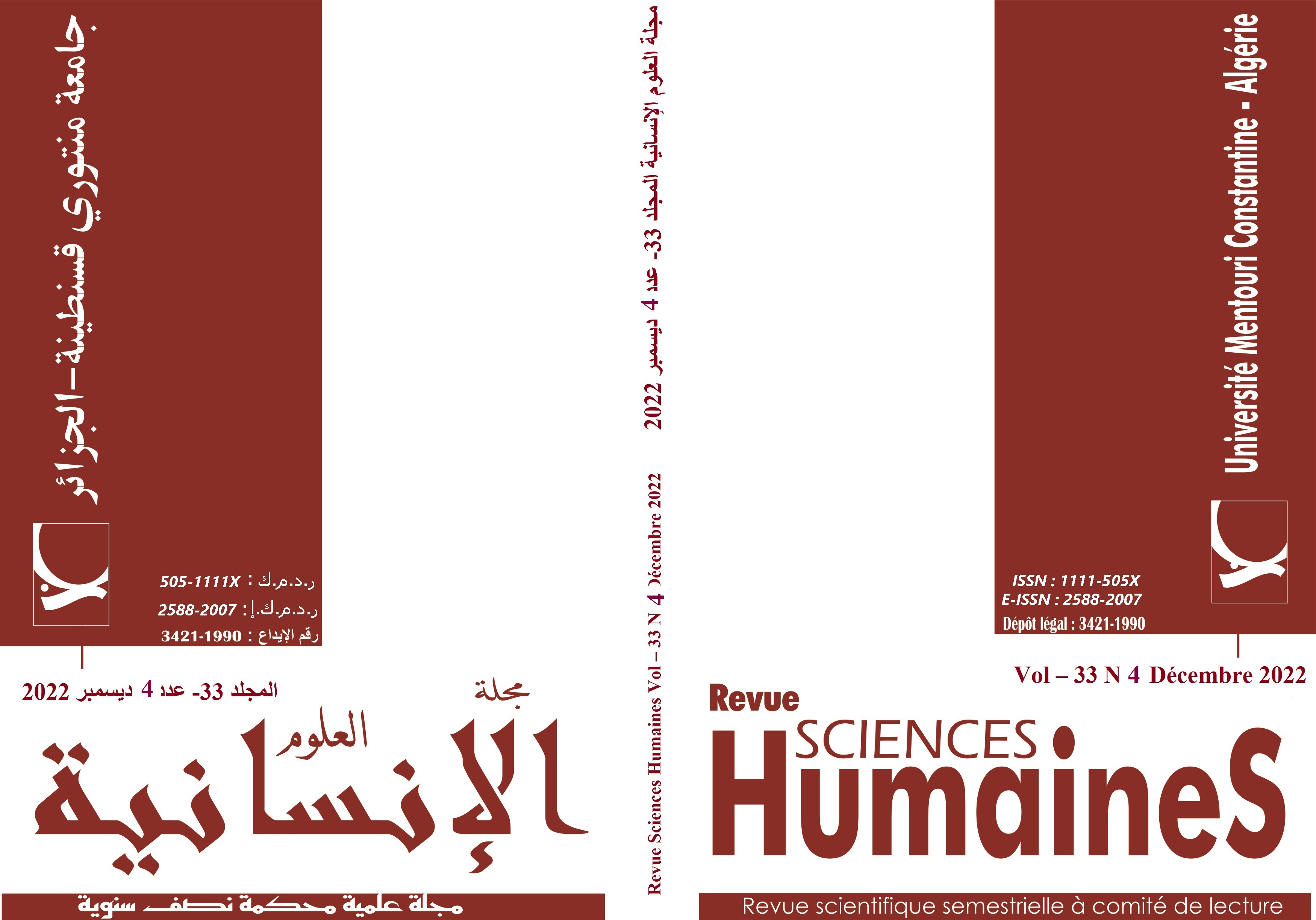Hedges in Biology Research Articles:
What Types and Frequency do Algerian Authors Use ?
Mots-clés :
article de recherche, hedging, biologistes Algériens, type et fréquenceRésumé
Cette étude se propose d’examiner l’utilisation des marqueurs linguistiques (hedging) dans les articles scientifiques écrits par des auteurs Algériens. Dans ce but, un corpus de 31 articles en biologie, parus dans 5 revues de publication locale, a été analysé en termes de type, de fréquence et de répartition. L'analyse quantitative indique que leurs auteurs utilisent différents types de marqueurs dans des proportions différentes. Cependant, la catégorie « Verbes principaux », plus précisément, la sous-catégorie « les verbes introducteurs de citation » est le type de marqueur le plus fréquemment utilisé. Les résultats de cette analyse suggèrent que ce choix rhétorique (prévalence de cette catégorie) permet aux chercheurs d’appuyer et de valider les résultats de leurs propres travaux. Les implications de cette étude contribuent à développer de nouvelles compétences dans l’enseignement de l’Anglais scientifique.
Téléchargements
Références
. Hyland, K. (1998). Hedging in scientific research articles. Amsterdam: John Benjamins.. http://doi.org/10.1075/pbns.54
. Blissett, M. (1972). Politics in Science. Boston: Little, Brown and Co.
. Hinkel, E. (2003). Adverbial markers and tone in L1 and L2 students' writings. Journal of Pragmatics, 1049-1068.
. Zadeh, L. A. (1965). Fuzzy Sets. Information and Control, 8 (3), 338-353.
. Lakoff, G. (1972). Hedges: A study in meaning criteria and the logic of fuzzy concepts. Chicago Linguistic Society Papers, 8, (183-228).
. Zuck, J. & Zuck, L. (1986). Hedging in news writing. In A. M. Cornu, J. Vanparijs, & M. Delahaye (Eds.) Beads or Bracelet: How Do We approach LSP? 172-181. Leuven, Belgium: Oxford University Press.
. Crismore, A., & William J. Vande Kopple. 1988. Readers’ learning from prose. The effects of hedges. Written Communication, 5(2), 184–202.
. Crompton, P. (1997). Hedging in academic writing: Some theoretical problems. English for Specific Purposes, 16 (4). 271-287. Retrieved from: https://www.academia.edu/478555
. Brown, P., & Levinson, S. (1987). Politeness: Some universals in language usage. Great Britain: Cambridge University Press.
. Salager-Meyer, Françoise. 1994. Hedges and textual communicative function in medical English written discourse. English for Specific Purposes, 13(2), 149–170.
. Hyland, K. (1996). Talking to academy: Forms of hedging in science research articles. Written Communication, 13(2), 251-281. Retrieved from :http://dx.doi.org/10.1093/applin/17.4.433
. Markkanen, R., & Schröder, H. (1997). Hedging: A challenge for pragmatics and discourse analysis. In Markkanen, R. & Schröder, H, (Eds.), Hedging and discourse: Approaches to the analysis of a pragmatic phenomenon in academic texts (pp.3-18). Berlin /New York: Walter de Gruyter.
. Nash, W. (1990). Introduction: The stuff these people write. The Writing Scholar: Studies in academic discourse, 8-30.
. Butler, C. (1990). Qualifications in science: Modal meanings in scientific texts. In W. Nash. (Ed), The Writing Scholar: Studies in academic discourse (pp.137-170). Newbury park, Ca: Sage.
. Falahati, R. (2004). A contrastive study of hedging in English and Farsi academic discourse. M.A thesis. Tehran University, Tehran, Iran.
. Martin-Martin, P. (2008). The mitigation of scientific claims in research papers: A comparative study. International Journal of English Studies, 8, 133-152.
. ElMalik, A.T. and Nesi, H. (2008). Publishing research in a second language: the case of Sudanese contributors to international medical journals. Journal of English for Academic Purposes, 7, pp. 87-96.
. Nasiri, S. (2012). Utilization of hedging devices by American and Iranian researchers in the field of civil engineering. International Journal of Linguistics, 4(2), pp-124-133
. Anthony, L. (2019). [Free computer Software Tool]. Centre for English language education in science and engineering. Waseda University: Tokyo. Retrieved February, 2019 from http://www.laurenceanthony.net
. Varttala, Teppo. (2001). Hedging in scientifically oriented discourse: Exploring variation according to discipline and intended audience. (Doctoral Dissertation). University of Tampere, Tampere, Finland). Retrieved from: http://acta.uta.fi//pdf/951-44-5195-3.pdf
. Hyland, Ken. (2008). Genre and academic writing in the disciplines. Language Teaching 41(4): 543-62.
. Hykes, J.M. ( 2000). A comparison of the use of modal verbs in research article professionals and non-native speaking graduate students. Master Thesis, Iowa State University).
. Yang, Y. (2013). Exploring linguistic and cultural variations in the use of hedges in English and Chinese scientific discourse. Journal of Pragmatics, 50(1), 23-36.
. Hyland, K. (1995). The author in the text: Hedging scientific writing. Hong-kong Papers in Linguistics and Language Teaching. 18: 33-42.
Téléchargements
Publié-e
Comment citer
Numéro
Rubrique
Licence
© Revue des Sciences Humaines 2023

Cette œuvre est sous licence Creative Commons Attribution - Pas d'Utilisation Commerciale - Pas de Modification 4.0 International.
















